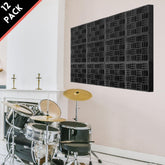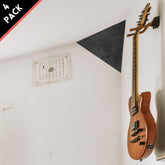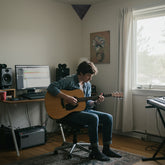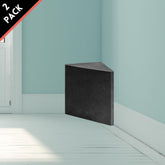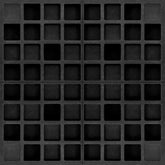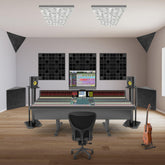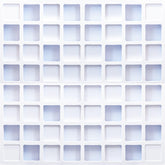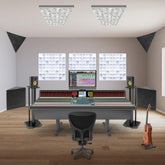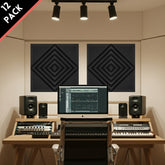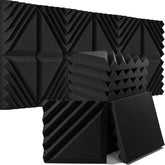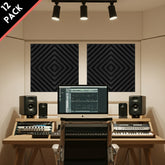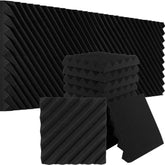Tame Flutter Echo: Top Acoustic Foam Panels for Home Studios

Flutter echoes muddy your mix and ruin the clarity of your recordings. These rapid reflections—bouncing between parallel walls—create a sharp, metallic “ping” that can distort your soundstage. To produce cleaner mixes, you need acoustic foam that absorbs mid-to-high frequencies before they bounce around the room.
The Grid Style Acoustic Foam Panel 12‑Pack by FOROOMACO was developed to solve this problem for home studio musicians. With its modern grid design and dense polyurethane foam, it targets the frequencies most responsible for flutter echo—leaving your recordings tighter and more controlled.
In this guide, you’ll learn:
- How acoustic foam tackles flutter echo and early reflections
- What to look for when comparing foam panels
- How FOROOMACO’s Grid Style Panels stack up to the competition
- Best practices for acoustic panel placement
- Why this product is ideal for DIY home studios
1. Why Flutter Echo Matters in Small Studios
Quick answer: Flutter echo distorts your listening environment by causing short-delay reflections. Acoustic foam panels absorb those reflections and improve sound clarity.
What Experts Say
- Acoustical Surfaces: Foam panels absorb early reflections by converting vibrational energy into heat.
- Sound On Sound Forum: Even treated rooms can benefit from strategic foam placement to eliminate flutter echo.
- Sound On Sound, Part 3: Targeted absorption is key to taming flutter echo and improving mix accuracy.
How FOROOMACO Compares
| Product | Material | Panel Count | Thickness | Special Trait |
|---|---|---|---|---|
| FOROOMACO Grid Style | PU Foam | 12 | 2 inch | Grid surface for even sound diffusion |
| Auralex Studiofoam | Open-cell Foam | 12 | 2 inch | Wedge pattern, industry standard |
| Soundproof Cow “Udderly Quiet” | Class A Fire-rated Foam | 12 | 2 inch | High fire resistance |
How to Get Started
- Step 1 – Identify Problem Areas: Clap your hands around the room to locate flutter echoes.
- Step 2 – Plan Strategic Placement: Focus on early reflection points—sidewalls, front wall, and ceiling above the desk.
- Step 3 – Install Panels Easily: Use removable adhesive like FOROOMACO's Mini Ear for clean, damage-free mounting.
- Step 4 – Test the Results: Record a mix and listen back on different devices to verify improvements.
Best Practice Tips
- Use all 12 panels to treat front wall, sidewalls, and ceiling reflection zones.
- Position panels symmetrically to preserve stereo image balance.
- Avoid placing foam too close to bass-heavy corners without additional bass traps.
Up next: How to choose the right foam design, thickness, and density for your room layout.
2. How to Choose the Right Acoustic Foam Panels
Quick answer: For flutter echo control in home studios, prioritize foam panels with at least 2 inches of thickness, a surface pattern that scatters sound (like grid or wedge), and a density above 20kg/m³.
Insights from Acoustics Research
- Gearspace Forum: Foam panels placed at early reflection points dramatically reduce flutter echo and help achieve a flatter frequency response.
Panel Selection Guide
| Use Case | Recommended Panel | FOROOMACO Match |
|---|---|---|
| Small Home Studio | 2” Grid Foam | Grid Style Acoustic Foam |
| Podcast Recording Booth | High-Density Panels | Slash Style Foam Panels |
| Full Room Treatment | Foam + Bass Trap Combo | Grid Panels + Triangular Bass Traps |
Installation Framework
- Assess: Use a smartphone reverb app or clap test to find problematic reflections.
- Plan: Cover opposing surfaces—especially between the left and right walls—to eliminate flutter echo bounce paths.
- Execute: Place panels in symmetrical pairs along the mix position, with focus on the sidewalls and front wall.
- Optimize: Test recorded vocals or guitars before and after installation to hear clarity improvements.
Real-World Recommendations
- Start with 12–24 panels for a typical 10x10 ft room.
- Install with non-permanent adhesive like Mini Ear pads to allow easy repositioning.
- Use a mirror trick to locate early reflection points from your speakers.
- Combine foam panels with rugs or curtains for enhanced acoustic control.
Coming up: Why the FOROOMACO Grid Style Panel stands out—and how musicians like you are using it to level up their sound.
3. Spotlight: FOROOMACO Grid Style Acoustic Foam Panel 12‑Pack
Built for musicians, producers, and content creators working in small rooms, the Grid Style Acoustic Foam Panel 12-Pack combines aesthetics and performance. Whether you’re treating flutter echo, reducing early reflections, or creating a cleaner stereo field—these panels are designed to get results without professional installation.
- Modern grid surface enhances diffusion and complements studio decor
- Made with high-density polyurethane foam (20kg/m³) for balanced absorption
- Each pack covers up to 12 sq. ft of acoustic treatment area
- Easy DIY mounting with FOROOMACO’s Mini Ear adhesive pads
Ted Kim, Guitarist & Sound Engineer, Founder of FOROOMACO
“I created these panels to help musicians like myself make better-sounding music at home—without needing to build a pro studio.”
→ Try the Grid Style Panel in your studio now
Frequently Asked Questions
-
What are acoustic foam panels used for?
They reduce flutter echo and early reflections, improving clarity, stereo image, and overall mix translation. -
Where should I place them in my studio?
Sidewalls, ceiling above your desk, front wall, and rear wall—especially around your mix position. -
Are grid designs better than wedges?
Grid patterns provide more uniform surface area and often blend better into modern interiors while still diffusing sound effectively. -
Will these fix low-end problems too?
Foam helps with mid-to-high frequencies. For bass control, use complementary bass traps like FOROOMACO’s Triangular Traps. -
What’s the best way to mount them?
Use Mini Ear adhesive pads—they’re removable, strong, and won’t damage your walls. -
How many panels do I need?
A 10x10 ft room typically needs 12–24 panels depending on layout and existing reflection points. -
Will they remove echo completely?
They dramatically reduce echo, but for full acoustic treatment, combine them with soft furnishings and bass control solutions.
ABOUT AUTHOR
House Live Engineer of Free Bird, a live house with the history of South Korea's indie music scene.
Single album/Regular album/Live recording, Mixing and Mastering experience of various rock and jazz musicians

